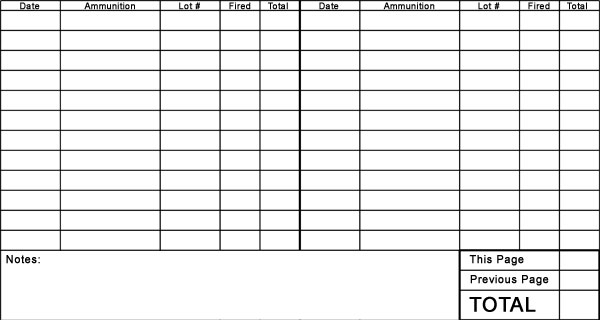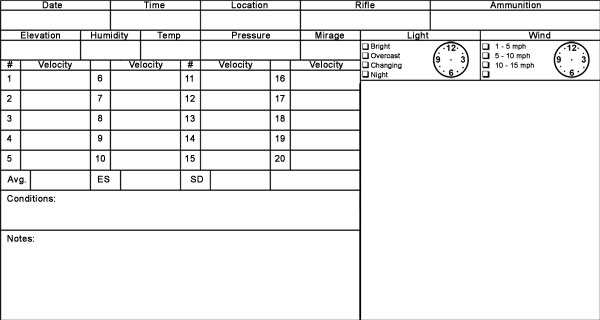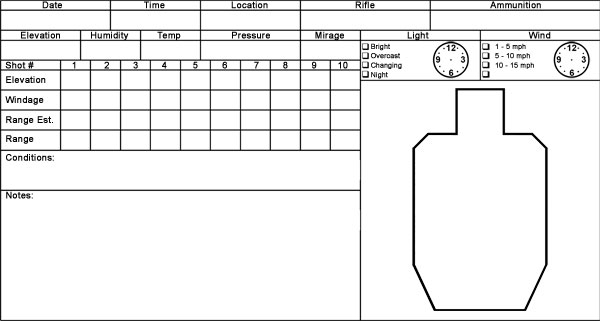![]() Phone: 605-554-1911 | Email : [email protected]
Phone: 605-554-1911 | Email : [email protected]
Rifle Data Book - A Lesson in DOPE
Aug 8, 2010Written By - Greg Dykstra
© Copyright 2009 - Present - Primal Rights Inc
ALL RIGHTS RESERVED
No part of this website or any of its content may be reproduced, distributed, or transmitted in any form or by any means without the express prior written permission of Primal Rights, Inc
How many rounds have I fired in this rifle? What is my come-up to 682yds when it's 73f? How much wind hold do I need in a 6mph 3 O'clock wind for a target at 500yds? How often am I cleaning the barrel? Am I becoming a better shooter, worse shooter, or staying the same? How good am I at shooting in a wind greater than 10mph?
These questions as well as many others can be answered by data logging. It is the quintessential skill of an accomplished shooter. From reloading to inventory to keeping a log of each shot fired and the result on target. Without accurate data, no real wisdom can be gained or passed on.
The first thing you will notice when you do a search for "rifle data book" is a few hundred different databooks and styles of data logging. Some you pay for, and some you can download for free. Storm Tactical and Impact Databooks would be a couple of the more popular out there. They have pre-made versions as well as build-your-own modular style. The idea of buying something printed on paper, of which I was going to use a lot of, just didn't appeal to me that much. By all accounts, Impact and Storm data books are of excellent quality, but I wanted more control over what I was using, so I went in search of pages I could print.
Building a databook has been quite a long process for me. I will outline my technique and where I purchased everything here in the hopes that I can trim some time off your journey if you want to get your own books started.
First off, I wanted to find a good cover to keep the pages as well as all the additional gear I would need together. I purchased most of my stuff at Triad Tactical. They have an excellent databook cover that isn't too spendy. It has ample pockets and is reversible. While you are there you will want to pick up a Mil-Dot Master, Sniper Template, and whatever else trips your trigger. Triad is an excellent company to deal with. They ship timely and their prices are competitive.
Your next stop should be an office supply store or website. I picked up my stuff at a myriad of places, from walmart to a little office supply store on the corner. A basic loadout of what you will need is:
Permanent marker - This is useful for marking bullet holes on the target, or writing in the log book. I keep 4 colors for marking different groups during load development and what not.
#2 Pencils - I put a couple of them in there. Can be sharpened with a knife.
Pen - Again, for writing stuff in the log book that you don't want to have the ability to erase.
3 ring binder - Half page. You want a 1/2 3 ring binder that fits a half sheet of paper. 1" will fit in the triad cover, but it will be tight. I had to chop the ends off mine to get it to fit. If you don't want the hassle, just order a modular binder from triad. (you'll need to find a corresponding hole punch then as well)
3 Hole Punch - Get an adjustable 3 hole punch so you can size it down to put your holes where they are needed.
110lb paper - You'll want some heavy paper to print on. 110lb seems heavy, but once you are in the field I assure you, it is not.
Paper Cutter - Something like THIS or THIS will work nicely.
Laminator - I use a Scotch LT901, but I'm sure just about any would work. Don't forget to buy the laminating pouches as well. I laminate all my reference pages that aren't meant to be written on.
Filing Index Tabs - These are useful for organizing your databook sections for quick reference.
Hole Reinforcement - Get some of these things to strengthen the more abused pages.
Calculator - The Casio HS-8VA is the perfect size for your databook.
Flashlight - I took a Maglite Solitaire and colored the lens red with a marker. Works like a charm, and doesn't destroy your night vision completely.
I also ordered a bunch of these Binders from franklin covey. The price is right! They don't have as many fancy pockets inside, but they will definitely work. My main rifles get the triad books, but the others that don't see much usage get these.
Not a terrible idea to get some "Rite in the Rain" stuff too. That way you can still log and operate in adverse conditions. Stuff is kinda spendy though!
That about covers it in the gear department. You can add or subtract things based on your own usage. On to the pages. If you see anything that could be added or improved on any of these pages, just let me know!

This page is what I use for the cover. Each data book should only require one of these. As you can see, it has fields for most things you would want to know about the rifle and its components. It also has plenty of data that will help you reloaders out there. Intimate details about the rifle's barrel and chamber as well as several rows to log specific loads that you have developed for this rifle. I often will have several loads for each rifle for different jobs. For instance, on a typical 308win I will have a 175SMK load for long range paper punching and steel, a 180gr RN subsonic load, and a 150gr nosler ballistic tip load for hunting. There is a section for your contact info in the case this databook or weapon is lost and found. I figure a reward will bring your thousands of dollars in gear back to you faster than a call to the local PD.

Next up is the barrel log. Not much to be said. You can use this page to keep track of how many shots are fired in the barrel, cleaning cycles, barrel swaps or re-barrels. Logging each round can really start to show you some patterns and get you in tune with what your barrel likes pretty quickly.

Now we are getting to the good stuff. Look as though I might, I did not find a suitable page for working up a load. Most were too cluttered. Date, time, location, rifle, elevation, humidity, temp, pressure, mirage, lighting conditions, wind strength and direction. All the obvious environmental variables that you will need to take into account. Then you can go into detail about each component and its lot number, and the individual measurements that will be of concern. Once you have everything filled out, then you can begin shooting a basic ladder test. There is room for 10 shots charge weight, and their velocity. In the blank space to the right, use your stencil or draw in your target on the right. After each shot, plot its POI in the space on the right. This will save you a lot of trips down range.

After your ladder test is complete, and you think you have a good load, its time to test it. Load up 20rnds of the winning combo from the lader, and fire them through the chrono. Again, log all your conditions before you begin shooting your string. Generally, I will shoot 5 and then let the barrel cool before firing the next string. This will give you time to go to the target, and mark your holes with one of the 4 different colored markers we talked about earlier. Each string gets its own color, and you can put a little swipe with the according color in that column to keep them separate. Another way is to plot your shots using a dot from the appropriate marker. Be sure to plot each shot on the right, as you shoot them. Anything less than 20 shots is not enough to provide an accurate Avg, ES, or SD. If you are happy with the performance of this load, then I attach my own nickname to the load, and keep "lot numbers" when I do a batch of them. This nickname/lot # can be easily written in the "ammunition" field in any subsequent target page. It will help you determine if you were screwing up one day at the reloading bench if you are shooting like crap and can't figure out why.

Here is the basic blank target page. The same environmental conditions fields combined with room for logging 10 shots on target. I find that any more than 10 results in the plotting section getting way too filled up. Use your stencil or draw your target to the right. Estimate your range if you wish, or plug in the actual range to target for each shot as you are about to take it. Write in your elevation such as "2.4" or some bigger number if you are one of those "minutes" type people. Same for windage. Often you will find a "call" section on here somewhere. I don't quite understand the benefit of that, so I left it out. If I'm pushing a bad shot, I'm fucking up. So my "call" is always going to be dead center. A miss is a miss, regardless of the fact that I knew it was a miss right after I squeezed the trigger. Plot your shots accordingly. If you make an adjustment after firing shot #1, log the change in wind or elevation for the next shot. Your initial elevation of 2.4mils resulted in a miss .4 mils low, so you'd run 2.8 mils for the next shot.

Same as above, just with the shape of the steel I most frequently shoot at drawn in already.
Here are all of the above pages in PDF form. Just download them, and print them. Be sure to tell your printer to NOT resize them. It will bitch and moan and say that some "clipping will occur" because there is shit outside the printable area or something... but its OK. This happens because I made them wider into the margins so I could squeeze more data in there, but most printers should have no problem printing them how they are suppose to.
System Info Page
Round Count
Load Development
Chrono Worksheet
Blank Target
IPSC Target
As I said, if you have any suggestions for improving these pages, or any requests for additional pages that you would want, just let me know.
Additional pages that I keep in each log book are for reference. I laminate each of these pages in a front and back style, so both sides are usable. Here is where you want to keep all of your informational pages that you can refer back to in the case you have a firing solution that is giving you trouble. Remember, if there is other info you want, you can add or remove pages to your liking. I'll list them in front/back pairs as I have them setup... but on most it really doesn't matter.
Angle Fire - This sheet basically gives you a breakdown of calculating your adjustment based on the angle and LOS distance to target.
Slope Dope - This is a quick and dirty table that will allow you to get an approximate horizontal distance without doing math.
10th Mil to Yards - This is another table that is excellent for range estimation that will save you some math and put you damn close. I'm not quite good enough to subdivide a reticle into 20th mil anyway... so this chart is every bit as good as running the calculator and its faster than using a mil-dot master. This table is front/back.
Wind sheet - This will give you all the basic calculations which will help you in making a wind call.
Movers - Just as you would think, this will give you the math to make a hit on a moving target. The likelyhood of you having time to run these figures on a mover is slim... so just figure on .5 mil per mph of target and be sure to spot your shot for the follow up. I still keep this page in there because hey... its good shit to know!
Conversions - This page gives me the formulas for converting all the standard measurements to metric. Damn good to have around should the need arise.
Target Dimensions - A list of typical objects and their size. Handy for mil range estimation. I just make my own in Excel.
Reticle Subtentions - Here I keep a page with all the measurements of my reticle. Its useful for mapping or telling range/size of targets. This is my GenIIXR. Most optic manufacturers will have a printout like that these days.
Mildot or MOA spec sheet - I keep a page outlining the USMC and Army mil dots in the chance I'm using someone else's optic and need to know how their mils are setup on the reticle.
I'm sure there is something I'm forgetting. Thats what the edit button is for I guess. As I said, it has taken me a very long time to accumulate all of the information, but mostly it took longer to develop my technique and the method of logging that worked for me. I suspect it will be the same for you. As with anything, it is what you make of it.
Throughout my life, accurate logging in both my shooting and reloading disciplines has helped me refine my technique and precision in both areas. I hate to think of all the valuable data and experience that I have not logged as a result of being too impatient when I was younger. I truly wish I would have started keeping detailed logs at a much younger age. Hundreds of thousands of rounds down range with my brain being the only place that experience is stored. Quite a shame really. While I may not keep a detailed log of each shot fired for my AK47 or similar lead hose, I find that the more detailed log I keep for my precision rifles - the better shooter I am with them.

